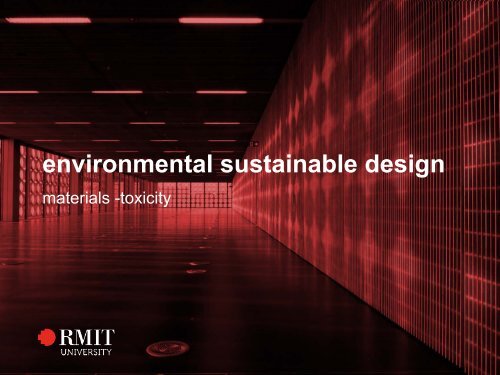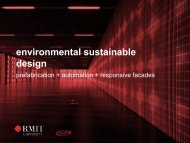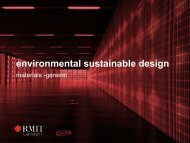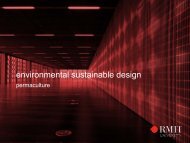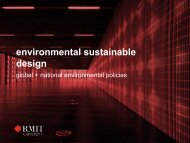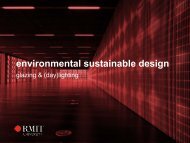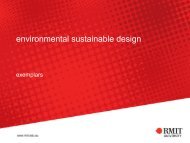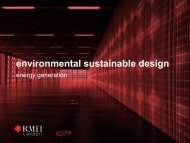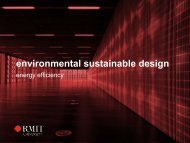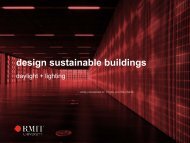#Materials -Toxicity
Create successful ePaper yourself
Turn your PDF publications into a flip-book with our unique Google optimized e-Paper software.
environmental sustainable design<br />
materials -toxicity
Silent<br />
Spring<br />
Chemical Companies' impact on biosphere<br />
brought to account.<br />
Establishes the U.S. E.P.<br />
(environment protection authority)<br />
1962<br />
the book that started it all.<br />
(it being the modern environmental movement)<br />
...sobering reading.
materials -toxicity<br />
On average 96% of each 24<br />
hours is spent indoors by<br />
the Australian population.<br />
1 .<br />
Australia State of The Environment : Human Settlements<br />
Report pp.4<br />
Pathogens found in HVAC filters
materials -toxicity<br />
Material selection should be holistically driven.<br />
Look at the entire manufacturing (and to a lesser<br />
extent transport) process. A building material may<br />
arrive on site, chemically inert but there may be<br />
high toxicity in raw materials.<br />
Consider each stage of Material Manufacture closely.<br />
• extraction + processing<br />
• manufacture +transport<br />
• construction + wastage/ leaking on site<br />
• use + occupation<br />
• disturbance (fire - wind - wear - degradation)<br />
I would consider this book essential reading
materials - toxicity<br />
control strategies<br />
There is an overarching strategy that can be employed for<br />
dealing with toxic materials.<br />
• removal:eliminate the hazard. Either remove an<br />
existing toxic material from the site, and disposed<br />
correctly. Or remove from the project prior to<br />
construction by checking material processes as<br />
outlined in the previously.<br />
• alternatives: substitute the hazard. Again through<br />
suitable material research determine a safer<br />
material.<br />
• enclosure:encase to prevent the material from<br />
causing harm. Again this applies to any scale from<br />
concrete bunding to painting over a more toxic<br />
material.<br />
• engineering: Active monitoring of the hazard/<br />
environment to ensure safe levels of material,<br />
before initiating the above.<br />
• OH+S: Working within a toxic environment and<br />
undertaking work practices/ procedures for<br />
reducing risk.
Sick Building<br />
Syndrome<br />
headache,<br />
eye, nose, and throat irritation<br />
fatigue<br />
dizziness<br />
nausea.
materials - toxicity<br />
indoor air quality<br />
Wherever or whenever possible consider natural systems<br />
to purify air.<br />
Most easily done with landscape design.<br />
for example...<br />
The Plants<br />
Areca Palm Chrysalidocarpus lutescens<br />
Mother in Law's Tongue Sansevieria trifasciata<br />
Money Plant Epipremnum aureum<br />
The speaker in the Video.<br />
Kamal Meattle has a vision to reshape commercial building in India<br />
using principles of green architecture and sustainable upkeep<br />
(including an air-cleaning system that involves massive banks of<br />
plants instead of massive banks of HVAC equipment). He started<br />
the Paharpur Business Centre and Software Technology Incubator<br />
Park (PBC-STIP), in New Delhi, in 1990 to provide "instant office"<br />
space to technology companies. PBC-STIP's website publishes its<br />
air quality index every day, and tracks its compliance to the 10<br />
principles of the UN Global Compact, a corporate-citizenship<br />
initiative.<br />
from ted.com
Indoor Air<br />
Quality<br />
removal<br />
control<br />
expell<br />
providing outside air quality is better than in... then<br />
adequate and controlled air changes
materials - toxicity<br />
building poisons<br />
Buildings can be a cocktail of toxic chemicals. It should be<br />
remembered here, that people die in house fires, not<br />
necessarily by being burned alive, but by asphyxiation,<br />
the inhalation of toxic smoke. Burning houses are not<br />
like some bonfire of eucalypt leaves and pleasant<br />
smells, but a combination of plastics and other<br />
synthetics that make breathing impossible. Firefighters<br />
are overcome by smoke, not heat.<br />
Chemicals to avoid in and around buildings include..<br />
• Organochlorines: prevalent to prevent termites and<br />
weed species.<br />
• Polyvinyl Chloride: while chemically inert<br />
undisturbed, creates toxic smoke when burned.<br />
• CFC's & Halons: Ozone depleting gases.<br />
• Mercury: Accumulates in the blood stream. Metals<br />
have been associated with Alzheimer's disease.<br />
• Formaldehyde is a fixative in MDF and is a known<br />
carcinogen.<br />
• Chemical Cleaning of Masonry (generally<br />
hydrochloric acid, significantly alters pH of<br />
landscaping.)<br />
endocrine disruptors: nasty stuff!
Materials<br />
• toxicity<br />
– Formaldehyde<br />
RMIT University©12/9/18 School of Architecture + Design 10
Volatile Organic<br />
Compounds<br />
Plastics<br />
Paints<br />
Resins<br />
Glues
materials - toxicity<br />
volatile organic compounds<br />
ahhh that new car smell....<br />
unfortunately it's probably killing you!
materials - toxicity<br />
asbestos<br />
• Any home built prior to the mid to late 1980's has some<br />
level of asbestos in it.<br />
• Any prolonged or intense direct exposure to asbestos<br />
can cause the fatal and incurable mesothelioma.<br />
• The material is insidious, and was used extensively for<br />
a wide range of building products.<br />
• The removal and disposal of asbestos, must be carried<br />
out by licensed contractors.<br />
• When undertaking renovations on existing buildings<br />
always minimise dust, and identify possible hazards.<br />
• If regularly painted and not degrading, some building<br />
products are relatively benign.
materials - toxicity<br />
asbestos<br />
30%<br />
of all homes<br />
White<br />
Grey<br />
Brown<br />
Blue<br />
(non)+friable<br />
still one of the most toxic materials<br />
still mined in Canada<br />
still used in India
Asbest<br />
os<br />
• roof sheeting and capping<br />
guttering<br />
• gables, eaves/soffitswater pipes and<br />
flues wall sheeting (flat or a<br />
weatherboard style) vinyl sheet flooring<br />
Codes of Practice:<br />
• carpet How to Safely and Remove tile Asbestos underlays and<br />
How to Manage and Control Asbestos in<br />
• zelemite the Workplace. backing boards to the<br />
switchboards flexible building boards<br />
• Imitation brick cladding<br />
fencing<br />
• carports and sheds
materials - toxicity<br />
history<br />
With increased pressure to reduce (sub)urban growth,<br />
more sites previously overlooked due to<br />
contamination may, by necessity, be built on.<br />
It is important to know the specific history of a site.<br />
Any previous industrial use has the potential for<br />
ground contamination.<br />
An environmental audit must be carried out to<br />
determine the type of contaminants existing on<br />
site. The results of the audit determine the<br />
suitability of a proposed use and what form of<br />
remediation works may be required.<br />
What was once a petrol station, may now be a B&B.
site contamination<br />
Toxic materials can indirectly<br />
continue to affect our health.


